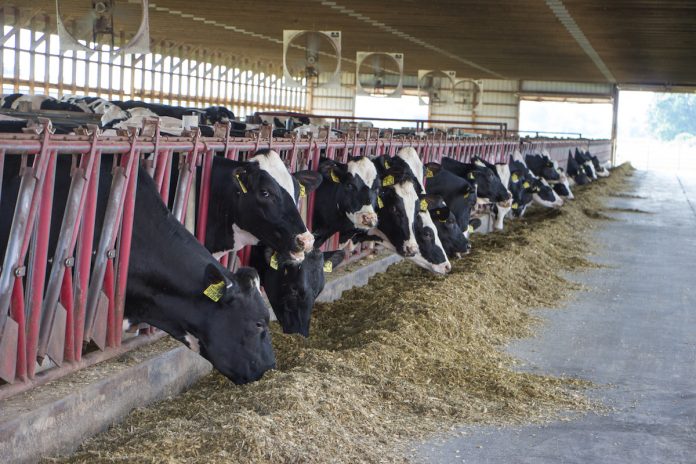Forage can provide most of the nutritional requirements of a beef herd during the fall and winter months. The challenge becomes the management of supplemental energy and protein due to low quality hay. Several options available to the cow-calf producer for the management of forage and supplement are discussed here.
Determine the nutritional value of the existing forage. To properly supplement livestock, each forage should be sampled and analyzed. Forage testing laboratories describe the proper sampling techniques for various forages. Contact your local agriculture extension educator for a test probe and instructions for submitting the sample to a laboratory.
Forage quality may have a dramatic impact on dry-matter intake. The higher the NDF (neutral detergent fiber) content of forage, the less forage an animal will be able to consume. Cattle will generally consume 1.2 to 1.5% of their body weight per day in forage NDF depending on forage quality. Cattle will consume lower amounts of low quality forage.
Protein supplements
Protein supplements can increase low-quality forage digestibility and intake while extending the grazing season. Limited amounts of high-protein supplements greater than 30 percent crude protein (CP) can be used with low-quality forages (less than 8% crude protein and 45% total digestible nutrients [TDN]). High-concentration protein supplements that are natural protein sources do not need to be fed every day. Simply feed twice as much every other day. When forage is of 8 to 10% crude protein content, a 20% crude protein supplement can be fed daily.
Caution: Do start on feeder cattle on diets with urea or feed to calves weighing less than 450 pounds. Instead utilize plant protein sources in starting rations for calves.
Cost of protein supplements
A simplified method of determining cost per unit of crude protein follows: Soybean Meal, 50% Crude Protein (as fed) at $390/ton:
2,000 pounds soybean meal x 0.50 = 1,000 pounds crude protein
$390/1,000 pounds = $0.39 cost per unit of crude protein
Utilize your local feed prices to determine cost per unit values. The prices utilized here are for calculation illustration.
Producers may also want to consider the mixture of protein being provided. These calculations don’t consider concentrations of rumen degradable protein and “bypass” protein sources. For proper rumen function, a portion of the dietary protein must be degraded in the rumen for microbial growth, and the rest can be absorbed later in the digestive tract. Providing a mixture of microbial protein and bypass protein will maximize animal production.
Selecting an energy supplement
In many cases, our forages may be adequate in protein to meet the requirements of gestating cows but may lack sufficient energy. Energy units may be Total Digestible Nutrients (TDN), Net Energy Gain (Neg), and Net Energy Maintenance (Nem).
Price per unit of nutrient will vary within the same feed depending upon the unit you use for comparison. Grain usually contains a readily available starch. Grain sugar and starch ferments rapidly in the rumen and may lower rumen pH, resulting in reduced feed intake and digestibility of forages. It is therefore recommended that the amount of grain be limited when used in a forage-based diet.
Certain feeds such as soybean hulls, corn gluten feed, beet pulp, and brewers grains are satisfactory energy sources, but the starch is more slowly degraded and does not alter rumen pH to the same degree as grain sources such as corn. Comparing the cost of TDN, we can estimate the cost of energy supplements as we have done for protein supplements in the previous example.
Corn valued at $212/T $212/20 = $10.60 per 100 pounds
$10.60/0.80 (%TDN as fed for corn) = $13.25 per 100 pounds TDN
Soybean hulls (SBH) valued at $304/T $304/20 = $15.20 per 100 pounds
$15.20/0.70 (% TDN as fed for SBH) = $21.71 per 100 pounds. TDN
Like protein sources, energy sources also vary amounts of mineral and vitamin available. For this reason, it is important to consider the cost per unit of nutrient along with the ease of handling, amount of concentrate fed, forage quality, and type.
In addition, protein and energy sources that differ significantly in dry-matter content should be adjusted and compared on a dry-matter basis. For these calculations, we have used (as-fed) values for crude protein and Total Digestible Nutrients.
If we had utilized book values, based on a 100% dry-matter basis, we would simply divide the cost per unit (CP and TDN) by the percent dry matter (decimal value) of the feed ingredient.
Typically cubes, cakes, blocks, and tub supplements may have a higher cost per unit of nutrient supplied. Moisture content of these products can significantly influence the value of nutrients provided and percent moisture or dry matter is not always available on labels. However, they can be easier to feed and require less daily management. In addition some even provide all of the trace mineral supplementation.
To illustrate cost difference in supplements consider the scenario below: A Late Gestation Cow weighing approximately 1250 pounds. For this example we will assume the cow is consuming a forage with the nutrient content of:
Crude Protein: 8%, NDF: 65%, and TDN: 58 percent.
Utilizing the prices for corn and soybean meal in our previous per unit calculations and the University of Kentucky Beef Cow Forage Supplement Tool our daily cost per cow is approximately sixteen cents.
If we take a 250-pound tub designed for mature cows under nutritional stress and costing $145, our cost is $.58 per day per cow (assuming 1 pound per day intake).
Simply calculating cost per unit of a single nutrient fails to take into account the benefits of added products sometimes found in tubs or pressed/cooked products.
However, always evaluate winter cost, it represents the greatest expense relating to beef cattle production.













